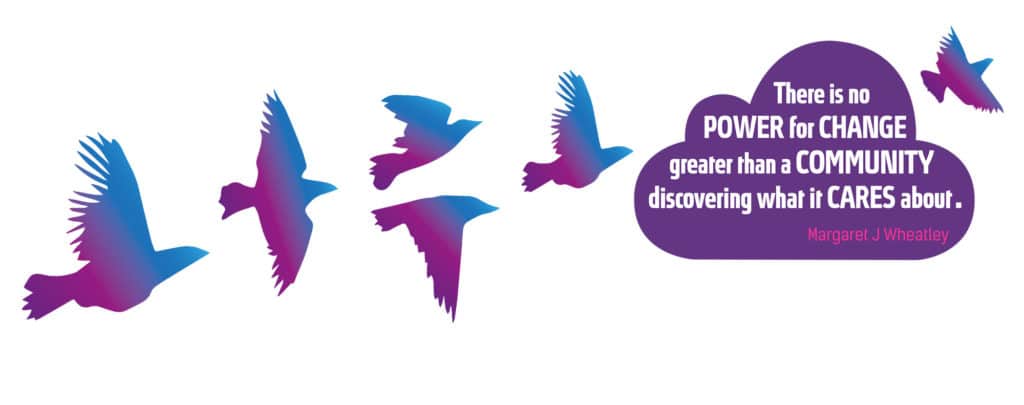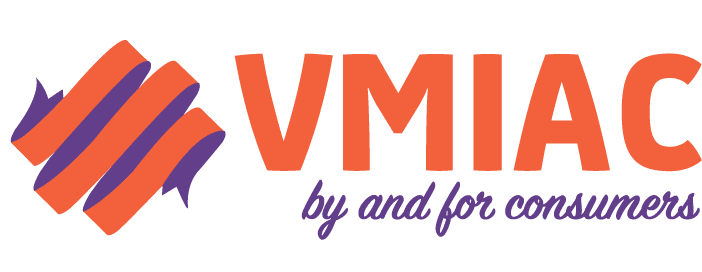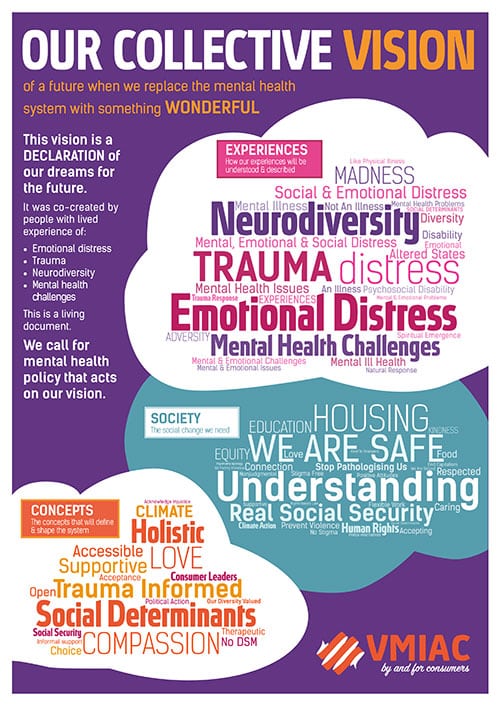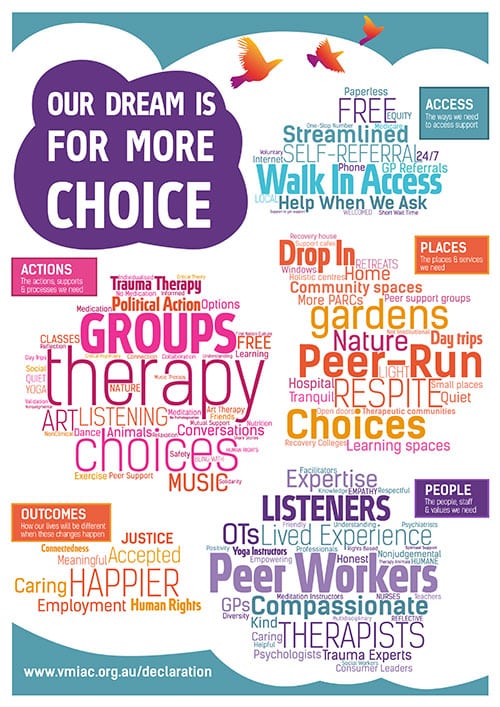
OUR COLLECTIVE VISION
The declaration is a collective dream about the future.
We dreamed about what it would look like when we replaced the mental health system with something extraordinary.
This declaration was collectively created by people from all around Victoria with lived experiences of emotional distress, trauma, neurodiversity and mental health challenges. It was first launched on 1 November 2019.
This is a living vision. It will keep evolving as long as we all keep dreaming.
LISTEN UP, OUR DREAMS MATTER MOST!
For too long, governments have listened to the wrong people about what’s needed in the mental health system.
The sector will always lobby for their interests first: more hospital beds, clinical jobs, and funding. And with that comes many things that we don’t want.
Family and carer interest groups can also lobby for things that we don’t want, like more compulsory treatment and detention.
The fact is, WE are the people who actually need support. And we don’t need people to speak about what’s in ‘our best interests’. We can speak for ourselves and know what we want and need.
We call on governments and mental health leaders to listen to our dreams and help us create the kind of society, systems, services, places and supports that matter to us.

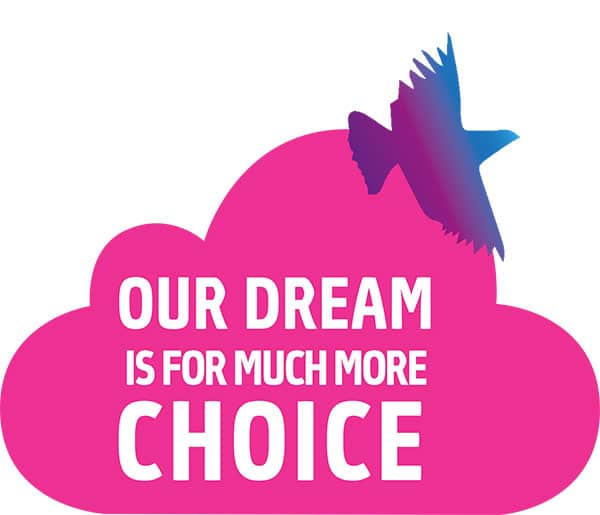
WE WANT MORE CHOICES
One theme stands above all others in The Declaration: We want more choice. We want lots of options and then to choose what works for us. Choice was a strong theme in every topic in The Declaration.
People spoke about diverse choices.
When we asked what support you needed, MEDICATION rated the same as MEDITATION.
When we asked what kinds of people you need to support you, PSYCHIATRISTS rated the same as YOGA INSTRUCTORS.
Many people dreamed about human rights, rights-based laws, non-coercive experiences and freedom.
THE EIGHT DREAM TOPICS
People’s dreams were grouped into eight topics. The sections below describe our dreams for each topic.
We have used ‘word clouds’ to display our collective dreams. These are set up so that the dreams that were shared by more people are bigger and bolder. However, even the smallest items in each word cloud matter. Please note that, for legibility, we have had to leave out dreams that were only mentioned by a single person. However, all of the dreams, in their full detail, will be shared later.
If we remember that choice is the overarching need, then these word clouds tell us the scope of those choices.
The topics include:
- OUR EXPERIENCES: How we conceptualise and
understand our experiences - SOCIAL CHANGE: How we want society to change
- CONCEPTS: The concepts that would shape a
wonderful mental health system - PEOPLE & VALUES: The people and values we need
for support - PLACES & SERVICES: The places and services
we want to access for support - ACTIONS & SUPPORTS: The things we need to
do, or receive, for support - ACCESS: How we need to access these things
- OUR LIFE OUTCOMES: How our lives will be
different
OUR EXPERIENCES
We have very diverse ways of understanding the experiences that are often called ‘mental illness’. However, less than 20% of people thought that ‘mental illness’ was a helpful or accurate description.

Our collective dream is that people will respect that there are many varied and different ways to understand and describe our experiences. Each of these worldviews matters if it is helpful to the person who believes it.
The language that most collectively describes our experience is this:
We are people with lived experience of emotional distress, trauma, mental health challenges and neurodiversity.
We note that this description includes different worldviews:
- A worldview that we have painful, human
experiences rather than a health problem - A social determinants worldview that our
experience is a normal response to trauma - A more traditional but hopeful view of mental
health and challenges to be overcome - A worldview that our experiences can be positive
too, and that rather than trying to change us, the world should be more
welcoming of diverse ways of thinking, feeling, perceiving and being
Eighty per cent of people in our survey liked at least one or more of these terms, and another 16% said they ‘could live with’ this language.
We also asked people about the words used to describe us, like consumer, patient, survivor, or ‘the mentally ill’.
The only option to be liked by more than half of us was person-first language (i.e., person with mental health challenges or person with lived experience). However, around 11% dislike the term ‘lived experience’. Every possible descriptor was liked by some and disliked by others—demonstrating significant variability in our preferences.
What about the term ‘consumer’? The views are very mixed: 24 per cent like it, 42 per cent can live with it, and 32 per cent dislike it.
The terms ‘users’ and ‘mentally ill’ were liked by the least amount of people, at 5% and 7% respectively.
SOCIAL CHANGE
We asked people to imagine a miracle had occurred and that society had changed to be wonderfully supportive. What would that look like?
Most of all, we dreamed of a society that shows us understanding and where we are safe:
“A social security system designed to support
people instead of punishing them.”
“First and foremost, people need to feel safe. Being free from violence and coercion is essential.”

Housing and real, supportive social security were imperative dreams for many. We were saddened by the current state of society when some people said their dream was ‘to be able to afford food’.
In a great society, we want connection with others, human rights and equity, respect, and a society that stops pathologizing our beliefs, thoughts, and emotions.
CONCEPTS
We dreamed collectively about what concepts would shape a wonderful mental health system. We imagined what it would take for us to disband the consumer/survivor movement because our work was done.
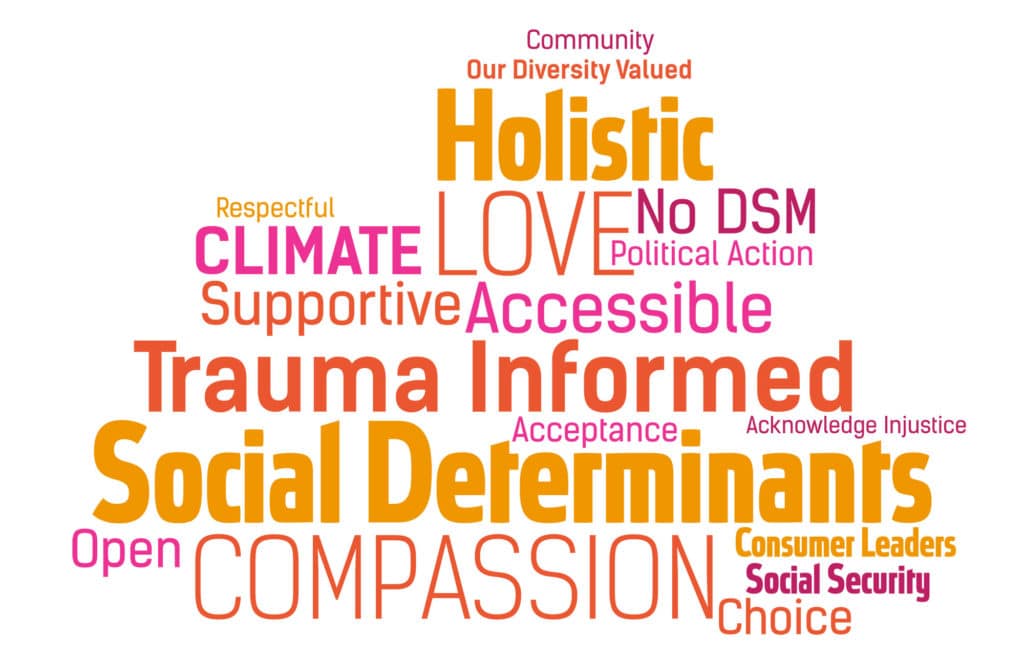
Our dream was that a wonderful mental health system would be shaped by compassion, love, and the social determinants of health. It would be trauma-informed and holistic, address climate change, and be accessible.
Not everyone can share all of these dreams. This is understandable, as society has historically not listened to us, often hurt us, and shown little interest in our dreams. One person described this future society as “impossible, utopian, and idealistic.”
PEOPLE AND VALUES
We asked what kinds of people we needed to support us and what skills and values they would have.
The two disciplines that were most often in people’s dreams were peer workers and therapists. We note that these are two of the least funded roles in the mental health sector.
The two qualities that we most often dreamed about were listening and compassion.
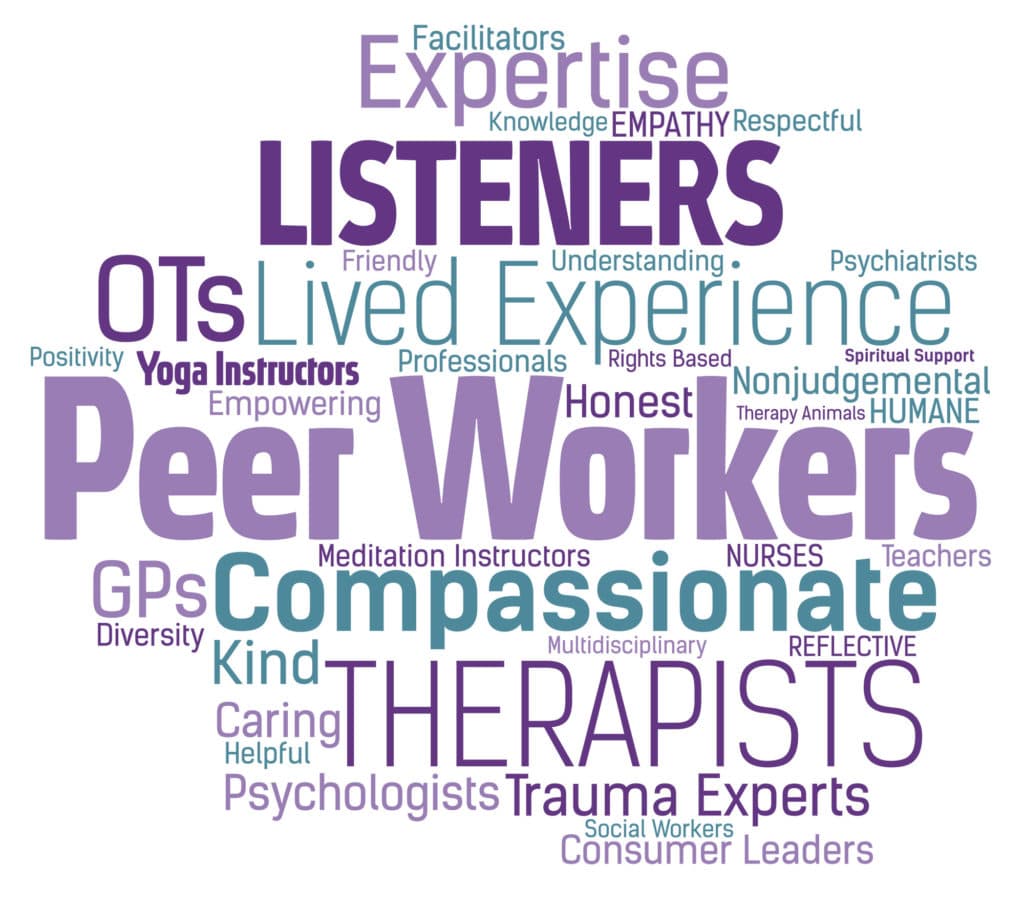
Some individuals dream about people and values:
“Having special people with kind people skills listen, understand and believe your story.”
“People providing support would be those like ourselves, people who know what it’s like to live in this world, who have experienced similar issues/challenges and lived similar experiences.”
“Having people to talk to who don’t panic and go into rescue/ carer/ freak out mode. And who let you be.”
PLACES and SERVICES
We explored what places, spaces and services we might want in a wonderful future. Would it be anything like the system we have today? No, it wouldn’t.
The places people most spoke about were peer-run services, which included many variants: peer-run respites, recovery houses, crisis centres, peer support groups, recovery colleges, and retreats.
Many people dreamed about the importance of nature in an ideal healing space: gardens, trees, lawns, and flowerbeds. Many also dreamed about light and windows.
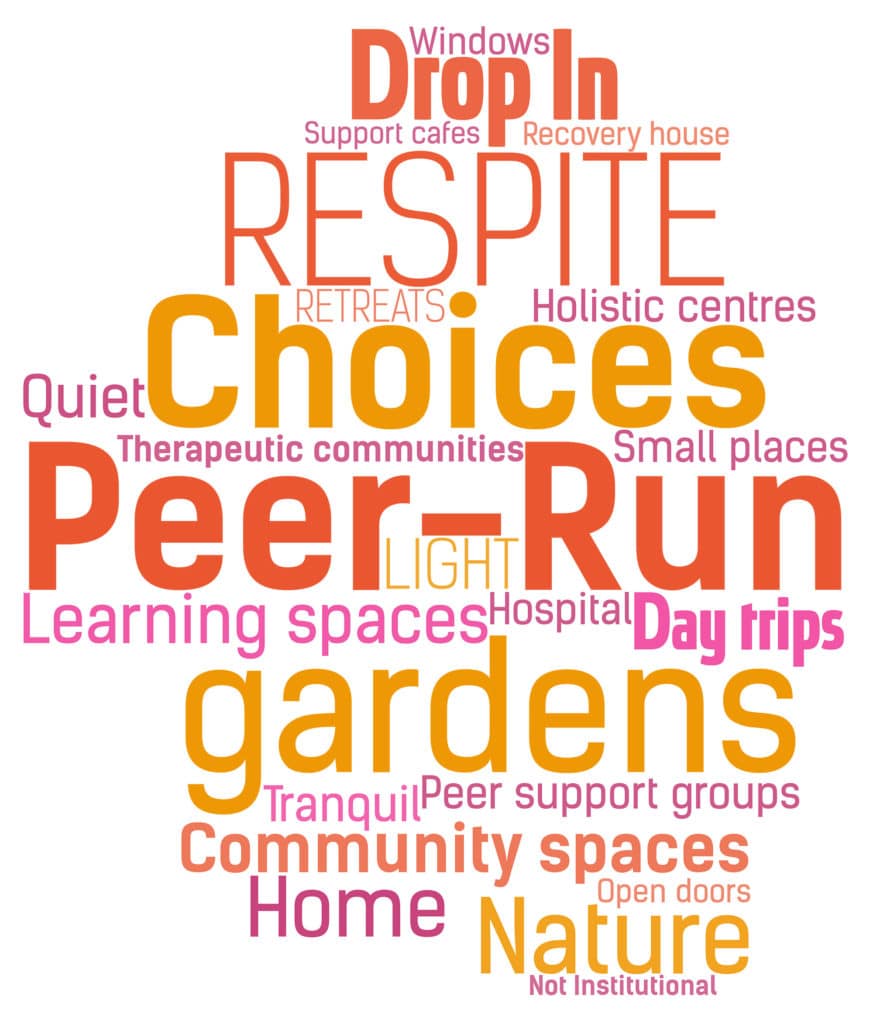
Places that might be more familiar but currently receive little funding were respite, drop-in services, community spaces, and learning spaces. Some people dream that the only place they should need is their own home.
A minority of people told us that hospitals were the best place for them in a crisis. However, these people also spoke about the need for hospitals to be nicer, cleaner, with more light, and with unlocked doors.
These are some individual dreams:
“Safe. Quiet. Calm. Tranquil. Open doors. Light. Windows. Gardens. Warm.”
“Community spaces that are calm or a space to shout loud.”
“Yes, for those of
us abused as children in institutions, we need non-institutional spaces.
Desperately. That means the physical
environment but also the way we access services.”
“Therapeutic
communities (both peer-run and other), respite houses in the community, nature
escapes, and community support spaces (NOT health clinics, but places for
the community to gather to offer mutual support). Learning spaces to explore and
understand diverse experiences.”
ACTIONS AND SUPPORTS
We asked people about the kinds of actions or support they needed, whether that was by themselves or provided by others. This was the topic with the most significant number of themes, which makes sense when we consider that:
- There are many pathways to healing
- Current mental health systems only offer
medication
Groups, classes and therapy were the most often dreamed-about supports.
Victoria used to have an extensive community support system that provided many groups and classes, but these have largely disappeared since the advent of the NDIS.
People wanted support groups, creative groups, therapy groups, peer support groups, nature activity groups, social groups, life skills and recovery classes, and many more.
Not everyone dreamed of groups. Some people said their dreams would be for individual support because groups can be complex.
Therapy is also impossible for most of us, yet it is dearly wanted.
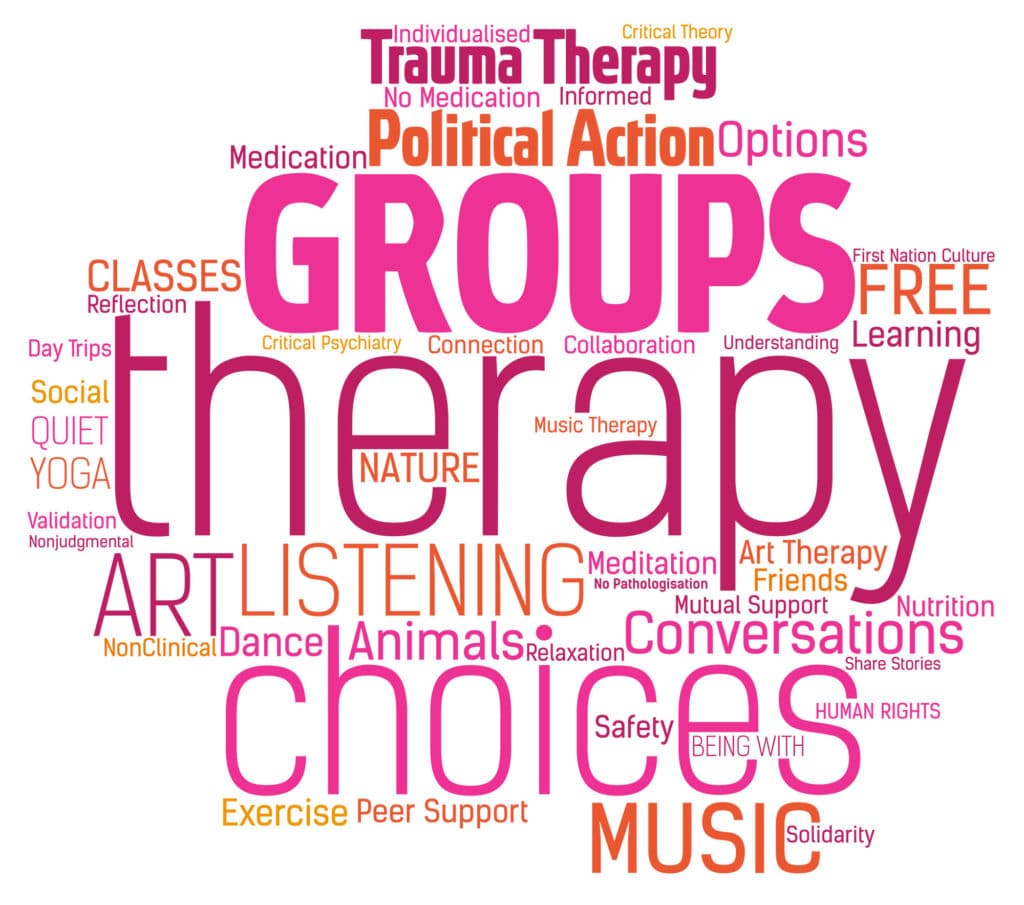
People dream about many different types of therapy, including trauma therapy, art therapy, music therapy, equine therapy, narrative and group therapy. Therapy is practically non-existent in the current public mental health system.
Medicare does not support enough sessions for any kind of in-depth work, and so therapy is simply not accessible for most of us—yet.
Music and art were commonly considered robust supports, as was taking political action. People spoke about being consumer activists, Black Pride, the #MeToo movement and speaking out about child abuse and family violence.
Conversations and listening were also strong themes. Many spoke about the deep need to be heard by another person and to talk about what was happening to them.
Some people said that the best people were not people at all but animals.
“Having dogs or cats in a space can sometimes do more than people to make us feel human & here again”
“Able to open up, ventilate, and relax… and they would listen…”
“It would be a place where I felt heard and understood without the shadow of diagnostics”
“Nurses should have to talk to the patients.”
ACCESS
We wanted to know how people would access supports and services in this wonderful future. This topic has fewer themes because the messages were very consistent.
Walk-in access was a dominant theme. We want to be able to just walk into a service and receive support. We want streamlined access, with no or much fewer forms and bureaucracy.
We want help when we ask for it. If we say we are in a crisis, we want to be believed, not assessed and sent away.
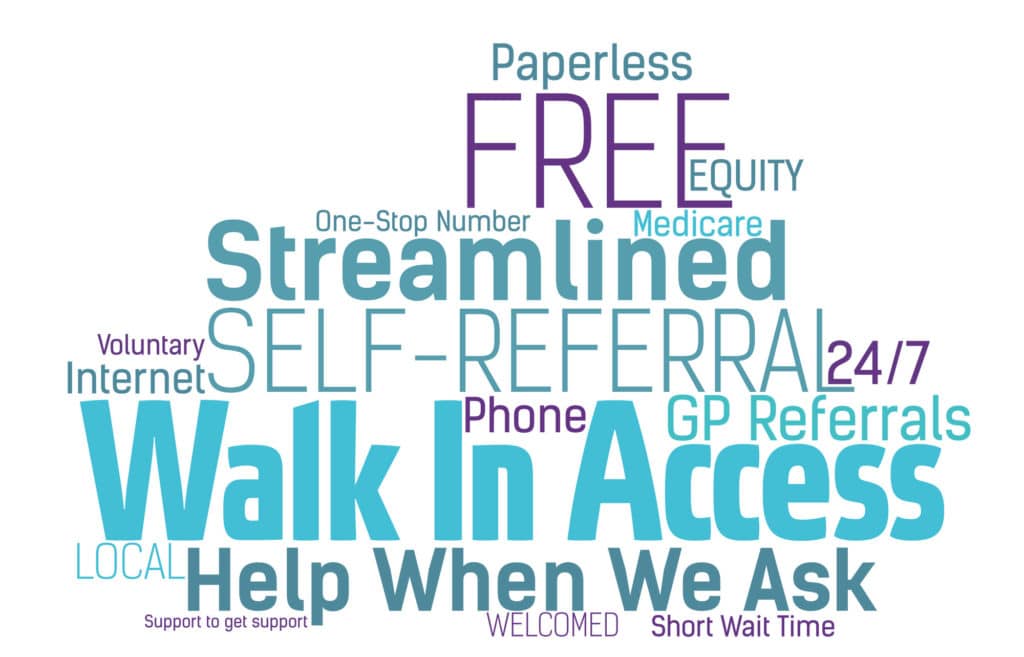
Importantly, we need services to be affordable and open when we need them. Mental health crises don’t just occur between 9-5, and we want a mental health system that responds to this.
OUTCOMES IN OUR LIVES
Finally, we asked people to imagine how their lives would be different if we could create a wonderful alternative to the current system.
People said they would be happier, feel accepted and cared for, have employment, justice, and human rights, and feel connected to other people.

Some individuals dreams about how our lives could be different in a better future:
“We will feel accepted and welcomed in the world, not judged, feared and controlled.”
“Free to be me and not hide in the corner. I could be a member of society.”
“Survivors would be empowered. We would be treated with respect and kindness and free from harm. Free from being re-traumatised by a system that does not understand the roots and causes of emotional distress. We would be safe and given hope of leading a meaningful life, free from suffering. We would have social connectedness and optimism. We would be validated and have the potential to heal and make meaning out of our lived experiences. We would be able to make sense of what has happened to us and be able to overcome the adversity so that we can thrive.”
WHAT WE DID AND WHAT’S NEXT
Why we developed The Declaration
The Declaration is an important part of VMIAC’s strategic plan, which includes a commitment to advocate for radical change.
The Declaration is important for many reasons. One is because there are an unprecedented number of royal commissions and inquiries into mental health, but what is common throughout is that the voices of lived experience are not being heard.
We also made this decision because we wanted to develop something hopeful and inspiring. We want The Declaration to be a beacon of what is possible.
We will continue to advocate against things we do not want, like seclusion, restraint, compulsory treatment, detention, and violence. But the Declaration is the other side of the coin–it’s what we are working towards.
How we developed The Declaration
This first phase of The Declaration was developed from July – October 2019. We used multiple methods to gather people’s dreams, including online surveys and face-to-face workshops. We also established a private online group for people to discuss the merging findings with us and help co-create the collective vision.
This was an entirely lived-experience-led initiative.
More than 190 people have contributed their dreams and ideas to The Declaration.
What’s next?
We sincerely thank the many people who shared their dreams and their time. This process was inspiring for many, but it was also emotional and painful for many.
At VMIAC, we commit to honouring the dreams shared in The Declaration and continuing to advocate for our voices to be heard and our dreams to be honoured.
